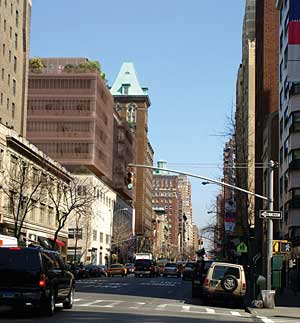Correction appended August 19, 2008
After sparking opposition and getting sent back to the drafting tables in January 2007, Foster + Partners has returned with a dramatically different design for an addition to a 58-year-old building on Manhattan’s Upper East Side. The revamped proposal has placated some, but not all, of the project’s critics.


Foster + Partners recently unveiled a new design (top) for an addition to a 58-year-old building in Upper Manhattan after the first proposal (below) was rejected.
The firm originally proposed erecting a 30-story elliptical glass tower atop the Parke-Bernet Gallery, a five-story, limestone-clad building at 980 Madison Avenue. The structure, completed in 1950, was designed by the New York firm, Walker & Poor, and sits within a historic district where new buildings can’t rise higher than 19 stories or 210 feet. Foster’s initial plan required a zoning variance, in addition to approval by the New York Landmarks Preservation Commission (LPC).
Area residents fiercely opposed the glazed tower, arguing that it was too tall and out of character for the neighborhood. One area resident famously described the project as “a glass dagger plunged into the heart of the Upper East Side.” The developer, Aby Rosen, asked Foster to modify the design.
In May, the architect unveiled the new scheme: a blocky five-story addition that is sheathed in bronze screens and mimics the proportions of the Walker & Poor building. The revised proposal, which complies with zoning regulations, has won over some critics. Alex Herrera of The New York Landmarks Conservancy said his organization is “pleased to see that the applicant had taken the public’s testimony and the commission’s comments seriously and returned with a completely different approach.” Lisa Kersavage of the Municipal Art Society says her organization finds the new design to be “acceptably appropriate.”
But not everyone agrees. Writer Tom Wolfe, who in 2006 penned a lengthy editorial in The New York Times against the first design, is back. During a LPC public hearing in June, he argued that Foster needs to “come up with something that has more meaning with the Upper East Side.” Peter Pennoyer, AIA, a board member of the Institute for Classical Architecture and Classical America, also opposes the project. “I don’t think you can put something on top of that building and not diminish the overall dialogue with the neighborhood,” he says, noting that the area includes structures by architects such as Warren and Wetmore, Cross and Cross, and I.N. Phelps Stokes.”
Foster + Partners declined to comment for this story. The proposal is still under review by the LPC, which expects to host another public meeting about the project in early fall.



Post a comment to this article
Report Abusive Comment